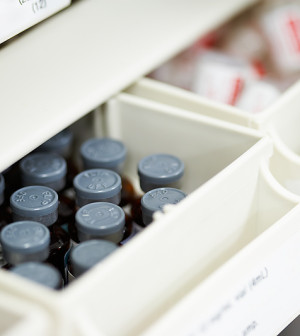- Skip Storing This Everyday Product in the Fridge Door
- Green Tea + B3 Pairing May Boost Brain Health
- Navigating Your Midlife Crisis: Embracing New Possibilities
- City Raccoons Showing Signs of Domestication
- Mapping the Exposome: Science Broadens Focus to Environmental Disease Triggers
- One Week Less on Social Media Linked to Better Mental Health
- Your Brain Changes in Stages as You Age, Study Finds
- Some Suicide Victims Show No Typical Warning Signs, Study Finds
- ByHeart Formula Faces Lawsuits After Babies Sickened With Botulism
- Switch to Vegan Diet Could Cut Your Greenhouse Gas Emissions in Half
‘Cycling’ Antibiotics Might Help Combat Resistance, Study Suggests


THURSDAY, Sept. 26Doctors might be able to overcome antibiotic-resistant bacteria by swapping out the antibiotics used to treat a patient, providing a “one-two” punch that keeps the germs reeling, a new Danish study suggests.
The strategy relies on a concept called “collateral sensitivity,” in which bacteria that become resistant to one antibiotic also become more vulnerable to other antibiotics.
The researchers argue that by swapping between antibiotics that play well off each other, doctors can stay one step ahead of bacteria and continuously avoid resistance.
“You cycle between drugs that have reciprocal sensitivities,” explained study co-author Morten Sommer, a lead researcher with the Novo Nordisk Foundation Center for Biosustainability at the Technical University of Denmark.
“If you become resistant to drug A, you will become more sensitive to drug B. That way, you can cycle between drug A and drug B without increasing resistance in the long term,” he added.
The U.S. Centers for Disease Control and Prevention recently declared antibiotic-resistant bacteria one of America’s most serious health threats, estimating that more than 2 million people are sickened and at least 23,000 die every year due to antibiotic-resistant infections. Doctors are finding it increasingly hard to fight some infections because many antibiotics have become useless against bacteria that have developed resistance to the drugs.
The new study was published Sept. 25 in the journal Science Translational Medicine .
The concept of collateral sensitivity has been around since the 1950s, but never received much attention, Sommer said.
“I think basically it was discovered during the golden age of antibiotic development,” he said. “There were new drugs coming onto the market all the time, and there wasn’t the need that there is today for a strategy to counter resistance.”
To test the concept, Sommer and his research team exposed E. coli bacteria to 23 different commonly used antibiotics, allowing the germs to develop resistance. Then they tested how each of the now-resistant bacteria responded to other antibiotics.
The researchers found that most antibiotics on the market can be “paired” with another antibiotic. As resistance to the first drug increases, the bacteria become more vulnerable to the other drug. In other cases, antibiotics can be used in a sequential deployment of three or four different drugs.
As many as 200 already approved antibiotics could be used in this manner, with one medication playing off one or more others, Sommer said.
“The timing will depend on the resistance development that’s occurring in the patient,” he said. “A doctor will want to cycle the drug when patient improvement slows or stops.”
This cycling strategy could be most helpful for patients suffering from long-term infectious diseases like tuberculosis or cystic fibrosis, Sommer suggested. “We think this treatment strategy will be primarily relevant when the patient is suffering a chronic infection,” he said. “In those cases, the infection continues for a long time, which allows for resistance to build.”
Collateral sensitivity cycling also could help increase the life span of many antibiotics, allowing them to remain useful tools for longer periods, the study authors added.
The researchers said their findings need further testing in animals and then in patient clinics.
This strategy likens bacteria to science fiction villains that automatically adapt to any weapon used against them, said Victoria Richards, associate professor of medical sciences at Quinnipiac University’s Frank H. Netter MD School of Medicine, in North Haven, Conn.
“Any antibiotic is a weapon against a bacteria,” she said. “With this approach, they could break that cycle of bacteria trying to adapt to our weapons.”
Richards said doctors and hospitals might want to consider implementing this sort of cycling strategy as soon as possible, as part of their overall plan to prevent resistance.
“It’s not like these are experimental antibiotics,” she said. “They are commonly used, and can be used in response to the bacteria responding to other antibiotics. It’s trying to keep one step ahead of the bacteria, by looking in a different way at antibiotics that have been used for decades.”
More information
For more on antibiotic resistance, visit the U.S. Centers for Disease Control and Prevention.
Source: HealthDay
Copyright © 2025 HealthDay. All rights reserved.










